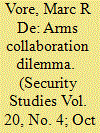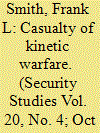|
|
|
Sort Order |
|
|
|
Items / Page
|
|
|
|
|
|
|
| Srl | Item |
| 1 |
ID:
109073


|
|
|
|
|
| Publication |
2011.
|
| Summary/Abstract |
One of the most dramatic developments in the field of armaments has been the rise of international collaboration over the last several decades. Nowhere has this phenomenon been more pronounced than the domain of military aircraft, where few states possess the resources to remain autonomous. Surprisingly, despite the theoretical advantages of interoperability and economies of scale, armaments collaboration has rarely, if ever, proven efficient. This article examines how states have employed governance structures, over time, to improve the collaborative process. To preview the conclusion, a stark trade-off exists between states' ability to control principal-agent dynamics and minimize collective action problems. Consequently, the dilemma of armaments collaboration is that any attempt to address principal-agent dynamics will aggravate collective action problems and vice-versa. With this in mind, it may be futile to continue reforming armaments collaboration because any governance structures will result in a deleterious combination of principal-agent dynamics and collective action problems.
|
|
|
|
|
|
|
|
|
|
|
|
|
|
|
|
| 2 |
ID:
109074


|
|
|
|
|
| Publication |
2011.
|
| Summary/Abstract |
The US military is responsible for protecting its forces from biological weapons. However, the Department of Defense has neglected biodefense-most of the funding for which now comes from civilian organizations rather than traditional military sponsors. Why? I argue that organizational frames explain military neglect and the rise of civilian biodefense. Because the military's frame of reference is defined by kinetic warfare involving projectile weapons and explosives, it neglects non-kinetic capabilities like biodefense. In contrast, the civilian Department of Health and Human Services has a different organizational frame and thus is more amenable to supporting biodefense. I test this theory against realism and bureaucratic interests. I find that research, development, and acquisition for biodefense support the ideational theory of organizational frames, which has important implications regarding the influence of specific ideas on national security policy.
|
|
|
|
|
|
|
|
|
|
|
|
|
|
|
|
| 3 |
ID:
109071


|
|
|
|
|
| Publication |
2011.
|
| Summary/Abstract |
How does manpower affect counterinsurgency? Important debates about counterinsurgency theory, military doctrine, force planning, and ongoing military operations revolve around assumptions about the role manpower plays in determining counterinsurgency outcomes. But these assumptions have not, by and large, been subjected to large-n analysis. This paper helps serve that role by examining new data on counterinsurgents' deployments across 171 campaigns since World War I. These data provide insight into a range of important issues, such as how force size should be measured, whether it is related to counterinsurgent success, whether troop nationality matters, and whether the role of manpower varies across contexts. Of these findings, the most notable is that conventional rules of thumb for force sizing, including the recommendation put forth in official US military doctrine, receive no empirical support. These findings therefore challenge the prevailing wisdom, while laying the groundwork for a range of future scholarship.
|
|
|
|
|
|
|
|
|
|
|
|
|
|
|
|
| 4 |
ID:
109072


|
|
|
|
|
| Publication |
2011.
|
| Summary/Abstract |
Though British foreign policy toward Iraq was officially separate from counterterrorism strategy, ideas about the "global war on terror" circulated in both policy milieus. This article deploys the concept of the security imaginary, adding insights from Pierre Bourdieu's notion of the habitus, to explore why this was the case. The British security imaginary, as structured by a secular social landscape coming to terms with "radical Islamism," was beholden to a series of problematic assumptions about religio-politics. This article focuses on British perceptions of the Islamist Jaish al-Mehdi militia between 2003 and 2004. Beyond the Iraq example, this historical incident suggests intimate connections between the experience of domestic secularity and warfare.
|
|
|
|
|
|
|
|
|
|
|
|
|
|
|
|
| 5 |
ID:
109069


|
|
|
|
|
| Publication |
2011.
|
| Summary/Abstract |
This article examines the manner in which rituals and symbols associated with sacred time have influenced conflict initiation. Leaders will time their attacks with sacred dates in the religious calendar if the force multiplying effects of sacred time, motivation, and vulnerability, outweigh its force dividing effects, constraint, and outrage. This is most likely to occur under three conditions: When conflict occurs across religious divides, when the sacred day is unambiguous in significance and meaning, and when rituals connected to that day will undermine an opponents' military effectiveness. I illustrate these effects with twentieth century examples, including the timing of insurgent attacks in Iraq and the launching of the 1973 Arab-Israeli War. By exploring the pervasive effects of religious calendars on modern combat, I hope to redirect the focus of the study of religion and violence away from the narrow preoccupation with fundamentalism and terrorism and onto the much broader range of cases in which religion shapes secular conflict in multiple-and often unexpected-ways.
|
|
|
|
|
|
|
|
|
|
|
|
|
|
|
|
| 6 |
ID:
109070


|
|
|
|
|
| Publication |
2011.
|
| Summary/Abstract |
What does it mean to say a state is angry? To answer this question, this paper theorizes a diplomacy of anger. Specifically, the diplomacy of anger involves a vehement and overt state-level display of anger in response to a perceived violation. Although the diplomacy of anger threatens precipitous escalation in the face of further violations, it can be ameliorated by conciliatory gestures and will subside over time absent new provocations. What is more, the diplomacy of anger can also exercise a reciprocal influence on the emotional dispositions of those that practice it. The diplomacy of anger thereby contributes to constructing particular issues as sensitive and volatile, and thus outside the realm of standard bargaining interactions. To examine the analytical purchase of this approach vis-à-vis standard accounts of coercive diplomacy, this paper looks in-depth at the 1995-96 Taiwan Straits crisis.
|
|
|
|
|
|
|
|
|
|
|
|
|
|
|
|
|
|
|
|
|